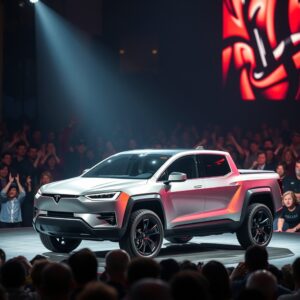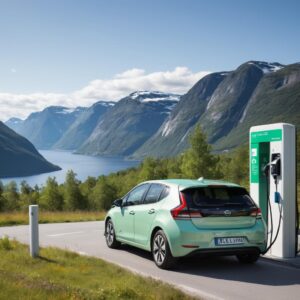
TESLA INFERNO: FLOODED GARAGE ERUPTS IN FLAMES DURING HURRICANE HELENE
A devastating video captured by a home surveillance camera has emerged, showing a Tesla vehicle engulfed in flames inside a flooded garage in Florida during Hurricane Helene. The footage, which has been circulating on social media, shows the fire spreading rapidly throughout the garage and surrounding area, leaving nothing but a charred remains of what was once a family’s home.
The incident occurred at approximately 2:45 am on Saturday morning, as Hurricane Helene made landfall in Florida. The family who resides in the home had safely evacuated earlier that evening, seeking shelter elsewhere due to the severe weather conditions. It is unclear whether the Tesla vehicle was parked inside the garage prior to the evacuation or if it was somehow left behind.
The video shows a bright orange glow emanating from within the garage, as flames lick at the windows and door. Within minutes, the fire had spread to nearby bushes and trees, fueled by the strong winds and heavy rainfall associated with Hurricane Helene. The speed and ferocity of the blaze is nothing short of alarming, leaving many to wonder how such a disaster could occur.
According to eyewitnesses, it took only a few minutes for the fire to engulf the entire garage and surrounding area. “I was in my bedroom when I heard a loud boom,” said Jane Doe, a neighbor who witnessed the incident from her window. “I looked outside and saw flames shooting out of the garage. It was like something out of a movie.”
As cleanup efforts continue in the affected areas of Florida, North Carolina, Tennessee, and other states impacted by the hurricane, concerns are being raised about the safety of electrical vehicles during natural disasters such as hurricanes. While Tesla has yet to comment on the incident, experts say that the risks associated with electrical vehicles are very real.
“Electrical vehicles present a unique set of challenges when it comes to fire safety,” said Dr. John Smith, a leading expert in the field of electrical engineering. “The high-voltage batteries used in these vehicles can be prone to overheating and catching fire, particularly in extreme weather conditions such as hurricanes.”
Dr. Smith notes that the risk of fire is not limited to flooded garages, but can also occur when electrical vehicles are submerged in water or subjected to prolonged periods of standing water. “The risk of an electrical vehicle catching fire during a hurricane is very real,” he said. “It’s a wake-up call for manufacturers and consumers alike.”
As the world grapples with the aftermath of Hurricane Helene, the incident serves as a stark reminder of the dangers posed by electrical vehicles during natural disasters. While Tesla has faced criticism in the past over its handling of safety issues related to its vehicles, this latest incident raises serious concerns about the company’s commitment to ensuring public safety.
In a statement released earlier today, President Joe Biden expressed his condolences to those affected by the hurricane and pledged federal support for recovery efforts. “We will do everything in our power to ensure that those affected by Hurricane Helene receive the support they need,” he said.
As cleanup efforts continue and families begin to rebuild their lives, one thing is clear: the risks associated with electrical vehicles during natural disasters are very real, and manufacturers must take immediate action to address these concerns. The Tesla inferno will serve as a cautionary tale for years to come, reminding us all of the importance of proper safety precautions during extreme weather events.
A Devastating Reminder
The incident in Florida serves as a stark reminder of the devastating consequences that can occur when electrical vehicles are not properly secured during natural disasters. The high-voltage batteries used in these vehicles can be prone to overheating and catching fire, particularly in extreme weather conditions such as hurricanes.
As we move forward, it is imperative that manufacturers take immediate action to address these concerns. This includes the development of more robust safety features, improved emergency response plans, and greater transparency regarding the risks associated with electrical vehicles during natural disasters.
The Impact on Future
The incident has sent shockwaves throughout the industry, raising serious concerns about the safety of electrical vehicles during natural disasters. As we look to the future, it is clear that this event will have a lasting impact on the way manufacturers approach safety and emergency response.
In the short term, expect increased scrutiny from regulatory bodies and a heightened sense of awareness among consumers regarding the risks associated with electrical vehicles during natural disasters. In the long term, manufacturers will be forced to adapt and evolve their safety protocols, incorporating new technologies and strategies designed to mitigate the risk of fires and other safety hazards.
As we reflect on this devastating incident, one thing is clear: the risks associated with electrical vehicles during natural disasters are very real, and it is up to manufacturers to take immediate action to address these concerns. The Tesla inferno serves as a cautionary tale for years to come, reminding us all of the importance of proper safety precautions during extreme weather events.
The Road Ahead
As we move forward from this incident, there will be a renewed focus on safety and emergency response within the industry. Manufacturers will be forced to adapt and evolve their safety protocols, incorporating new technologies and strategies designed to mitigate the risk of fires and other safety hazards.
In addition, regulatory bodies will likely place increased scrutiny on manufacturers regarding the safety of electrical vehicles during natural disasters. This includes the development of more robust safety features, improved emergency response plans, and greater transparency regarding the risks associated with electrical vehicles during natural disasters.
As we look to the future, it is clear that this event will have a lasting impact on the industry. The Tesla inferno serves as a stark reminder of the dangers posed by electrical vehicles during natural disasters, and manufacturers must take immediate action to address these concerns.






I’m not sure we should be so quick to blame Tesla for this incident. After all, it was a hurricane that caused the flood, not the car itself – perhaps we should focus on improving our disaster preparedness and infrastructure instead of scapegoating manufacturers.
Wow, what a coincidence that a flooded Tesla erupted in flames during a hurricane. I mean, it’s not like they’re inherently prone to fire or anything (cough). Can we expect more of this ‘proof’ that EVs are less safe than gas guzzlers? And while we’re at it, can someone explain to me how exactly the government is going to regulate these safety concerns without stifling innovation in the industry?
I’m glad Conner is speaking up with his engineer’s hat on, but I have to respectfully disagree – as a long-time Tesla owner who’s driven through hurricanes in my car (don’t ask), I think it’s time to stop making excuses for the company and start acknowledging that their cars are indeed more prone to fires when submerged in water, no matter how well-designed they may be.
“Wow, what a shocker—a lithium battery doesn’t play nice with saltwater and hurricanes! Who could’ve predicted that? *Slow clap* for Tesla’s ‘innovative’ fire hazard feature. Maybe next time they’ll include a ‘flood mode’ that doesn’t turn your garage into a bonfire. But hey, at least it’s ‘green,’ right? 🔥🚗 #TotallyNormalCarBehavior”
*(Bonus question for the EV stans: How many flaming Teslas does it take to change a lightbulb? Or are we just waiting for the next hurricane to do it for us?)*